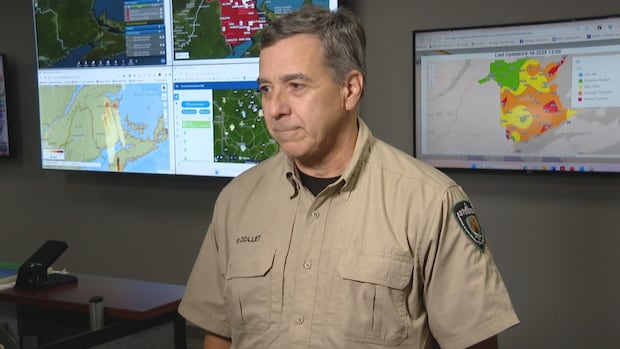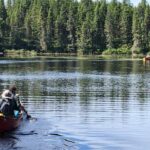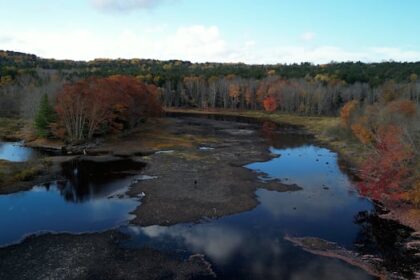New BrunswickInside the wildfire co-ordination centre in Fredericton, experts like Roger Collet track live data about weather patterns, smoke plumes and hotspots to manage firefighters and other resources being deployed to fight wildfires.Weather patterns, GIS mapping and heat signatures determine when, where firefighters are deployedKatelin Belliveau · CBC · Posted: Aug 20, 2025 6:24 AM EDT | Last Updated: 2 hours agoRoger Collet, the province’s wildfire prevention officer, says all of the planning to fight active wildfires comes from within one building in Fredericton. (Silas Brown/CBC News)The brainpower behind New Brunswick’s plan of attack against wildfires is hard at work inside the Hugh John Flemming Forestry Centre in Fredericton.Roger Collet’s eyes dart back and forth among a dozen computer and television screens.As a wildfire prevention officer, he is the man behind the curtain, managing how firefighters and other resources are sent out to different locations based on weather patterns, burn tracking and other data he monitors in real time.”We start 7 … in the morning, we’re here till 9:30 at night,” said Collet, who has worked with the centre for 10 years.WATCH | Wildfire prevention officer gives tour of centre: Blazes aren’t just fought on scene. See inside N.B.’s wildfire headquartersA team of wildfire prevention co-ordinators works out of a room at the Hugh John Flemming Forestry Centre in Fredericton, organizing resources and tracking the fires burning across the province. Most new wildfires in the province are reported to the centre, or to specific districts on the ground. Then Collet and his team use data to choose the best way to attack the fire.”If they need aircraft on the fire, they order those through us … and we’ll send them,” he said, pointing to a large screen that tracks the exact locations of water bombers and helicopters as they fly.Thirty-one active fires were burning in the province as of Tuesday afternoon. Five of those are being monitored and are labelled by the province as out-of-control fires.Live data about weather patterns, smoke plumesThe wildfire co-ordination centre, inside the Hugh John Fleming Forestry Centre in Fredericton, tracks live data which co-ordinators use to deploy resources to wildfires. (Silas Brown/CBC News)Each screen in the room displays information that, when analyzed together by experts, can make deploying resources more targeted and efficient.The one the team uses most often, Collet said, tracks the weather, including any incoming rain or gusts of wind, which can tell them ahead of time how fast a fire might move or grow. Hurricane Erin expected to bring wind, strong waves to Atlantic provinces “We have our weather fire behaviour analyst, so kind of a weather guy who tells us what the day is going to be like, how the fire is going to react,” Collet said.The team also has a specialist doing GIS mapping, a process that layers data about geography and the environment onto a single map to provide a better idea of what the ground looks like in a certain area.Satellites are used to scan the province to find what Collet calls hotspots. These are zones that radiate heat on the ground, which can give teams a heads-up about a new fire. The team also tries to intercept fires by tracking smoke plumes, which help point to where the fire might be.Another screen shows the province’s public fire dashboard, which tracks the status of ongoing and new fires based on a colour system.”Red is out of control, orange is contained, there’s a purple one there that’s being monitored,” Collet said. “Green is being patrolled, there’s a yellow one … it’s under control, and the blue one is when the fire is called out.”The team, which also includes two duty officers and note takers, uses the space to meet and have daily briefings on each of the fires.”When it’s chaotic in here, sometimes we say we’re going to do something, and you forget about it,” Collet said. “So the note taker kind of reminds you, ‘Hey, you were supposed to do this.'”Collet said the most surprising part of his job is how quickly things can change.Keeping firefighters safeBetween two television screens on the wall is a large sheet of paper.On it, a handwritten list reminds the team of the most important things it’s aiming to save during a fire.”What’s our number one priority? Life,” Collet said.Collet says checking up-to-date weather trackers is something the team relies on daily to understand how wind and rain might change how firefighters are deployed. (Silas Brown/CBC News)Then comes critical infrastructure such as hospitals and seniors homes. Primary and secondary homes and cottages are next, and last are resources — such as trees.Making sure firefighters, including many from outside New Brunswick, are as safe as possible inside the forests is also a priority.”We try to make sure that all the firefighters are well anchored, that they’re not in a dangerous spot,” he said. “I mean, it’s dangerous work no matter what you’re doing. But [it’s] knowing that you have escape routes, knowing where you should go and what you can do, and knowing your capabilities and you’re limitations, right?” Weather helping firefighting efforts in N.B. as 4 fires burn out of control Colett said that in the decade he’s worked at the centre, the amount of training that first responders get has increased. And so has the level of technology and data at their disposal.”But there can always be surprises,” he said.”Things can change quickly. So we keep an eye on all of that stuff throughout the day.”ABOUT THE AUTHORKatelin Belliveau is a CBC reporter based in Moncton. With files from Prapti Bamaniya and Silas Brown
How a small team of experts co-ordinates New Brunswick’s wildfire response











